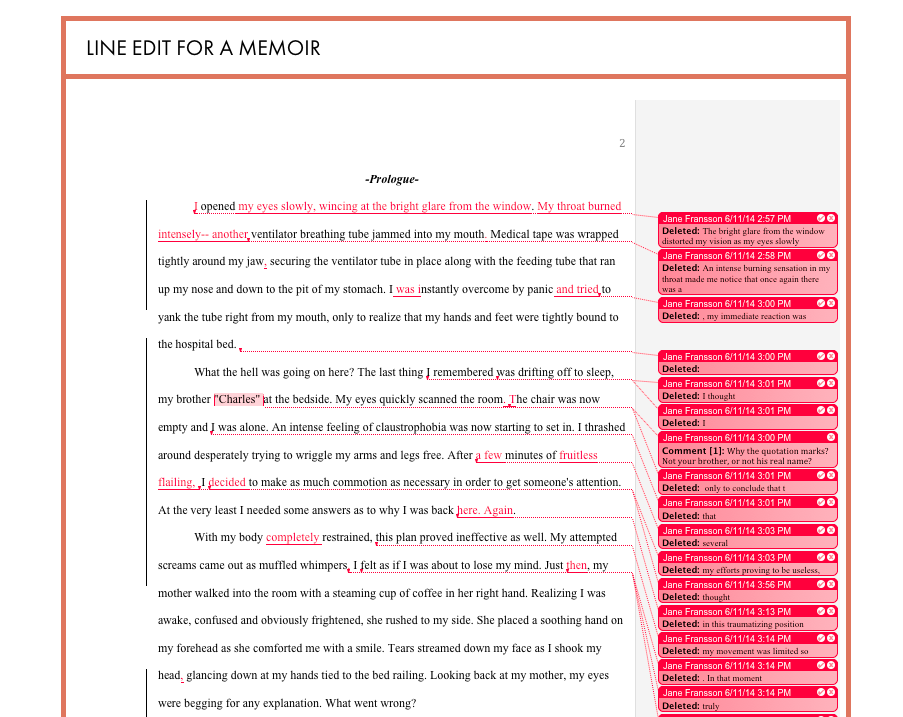Critique Vs. Comprehensive Edit

Woohoo! You’ve finally finished your manuscript (congratulations, by the way), and now it’s time to start the editing process. But, wait—are you sure you’re ready for this next step? Check out this post first to figure out if it’s time to submit your manuscript for professional editing.
Once you’re completely confident that your manuscript is ready for a professional edit, your editor has to determine whether a critique or a comprehensive edit would benefit you most.
Below, we’ll discuss the differences between the two. Let’s get started!
Here’s a list of questions to help you decide if you’re ready for editing. Subscribe to receive this extra resource.
Manuscript Critique
The manuscript critique (also known as MC) is a general assessment of your manuscript. It’s like a bird’s-eye view of your entire story. During this type of critique, we’ll look at the overall story, focusing on the three Ps: plot, person, and pacing.
Here’s what we tackle in a manuscript critique:
- Character Development
- Point of View
- Perspective
- Character Voice
- Plot Structure
- Overall Theme
- Overall Consistency
- Overall Weaknesses Within the Story
Here’s what we don’t tackle in a manuscript critique:
- Grammar
- Misspelled Words
- Awkward Phrasing
- Repetition
- Inconsistent Dialogue
Consider a manuscript critique an entry-level edit. It’s where your editor will look at your whole manuscript and show you the areas that need tightening up to make it stronger and more cohesive. You’ll receive actionable advice on how to improve your story in the form of an editorial memo.
What’s an editorial memo?
An editorial memo is the editor’s thorough response to your manuscript. The editorial memo opens with a general statement about your manuscript. The editor offers his or her response to your story. Then, the editor delves into a detailed critique of your story and how it can be revised. The editor will cite specific passages and share ways to improve your story.
Here’s an example of what you may find within an editorial memo:
- Examples of inconsistent pacing along with advice on how to fix it
- Advice on how to strengthen the overarching themes within your book
- An examination of your narrative voice and ways to enhance it
- Ways to reconstruct the plot so intensify the story
- Ways to pinpoint opportunities to build and develop characters
- Ways to identify areas within the story that are weak and can be strengthened
- Ways to identify areas that should be eliminated
Here’s a look at two examples of editorial memos. It’s important to note that an editorial memo isn’t a closed directive. If you have questions for the editor, we encourage you to follow up. Your editor will be happy to offer additional clarification to support his or her notes in the editorial memo. You can also ask for further advice based on the editor’s suggestions.

You can meet with the editor face to face (depending on the editor’s location), or you can also meet virtually over Skype. Of course, your editor is also available via email and over the phone.
How long does it take to receive a Manuscript Critique?
It depends on the editor’s schedule, but you can expect a manuscript critique within five to seven weeks.
How much does it cost?
A manuscript critique averages between $1000 and $2500. It varies based on the length of your manuscript. Determine your quote here.
Comprehensive Edit
While a manuscript critique is an entry-level type of edit that can help clarify your story, a comprehensive edit is the most detailed editing package we offer. Keep in mind that not every manuscript is ready for the comprehensive edit.
In fact, we often recommend that you submit for a manuscript critique first so that your story is as tight and cohesive as possible. Next, you’ll work on the suggestions given to you through your editorial memo. Finally, you’ll submit your manuscript for a comprehensive edit where we’ll dissect your story in every way imaginative—from plot to perspective, tension to tone, dialogue to development, and more.
A comprehensive edit contains the following:
An Editorial Memo
Similar to the editorial memo delivered in a manuscript critique, the editorial memo for a comprehensive edit discusses ways to improve the overall structure, ideas, and pacing of your story.
However, for a comprehensive edit, the editorial memo is much more in-depth.
Instead of addressing structural issues that you’ve since corrected as a result of your manuscript critique, the editor now has more room to advise you on how to make your story even stronger and more poignant. He or she can focus on the elements and devices you can use to craft a more compelling story.
Editorial Comments on the Manuscript Itself
Your editor will write notes and comments in the margins of your manuscript to point out opportunities for improvement. These notes may indicate any or all of the following:
- Scenes that lack necessary tension
- Scenes that interrupt or take away from the story’s momentum
- Parts of your story that seem out of place or implausible within the world that you’ve created
- Underdeveloped characters
- How to use specific events to further develop characters
A Line Edit on the Manuscript Itself
The line edit is the most detailed part of the comprehensive edit. During the line edit, the editor meticulously scours your manuscript for any weakness, line by line—hence the name.
All line edits are made in Microsoft Word so that you can easily see the editor’s changes (made in suggestion mode). You can then accept, reject, or modify the editor’s changes as you see fit. The line edit is an intensive treatment of your manuscript, and not for the faint of heart.
Here’s what your line edit may suggest:
- Opportunities to tighten your dialogue
- Words or phrases that should be deleted or reworded
- Unnatural phrasing
- Departures in tone and style
- Run-on sentences
- Muddled scenes
- Poor transitions
- Redundancies
- Cliche phrases, passages, characters
- Poor or halting rhythm in prose
This isn’t an exhaustive list by any means. Your line edit will be specific to your manuscript, and will include everything you need to create a more harmonious story. The point of a line edit is to deliver a story with fluid, flawless prose (or as close as possible!).

How long does it take to receive a Comprehensive Edit?
Because of the detailed nature of a comprehensive edit, this type of edit may take twice as long as a manuscript critique. You’ll receive a comprehensive edit back within six to twelve weeks. Of course, the exact timeline will depend on your editor’s schedule.
How much does it cost?
A comprehensive edit averages between $1500 and $5000. The cost varies based on the length of your manuscript. Determine your quote here.
So, What’s the Next Step?
The next step is to fill out your name and email here and then upload a sample of your manuscript. We’ll review it and then pair you with the perfect editor for your manuscript. You’ll find out more about them, along with a list of books that they’ve edited. From there, your editor will do a test edit and provide a consultation call to discuss your manuscript.
Next, you’ll receive a detailed explanation of the type of edit your editor believes is best for your manuscript (critique vs. comprehensive). After you accept, your editor will get to work editing and revising your manuscript.
Are you ready to take the next step? We can’t wait to work with you! Fill out your details here.
Here’s a list of questions to help you decide if you’re ready for editing. Subscribe to receive this extra resource.




